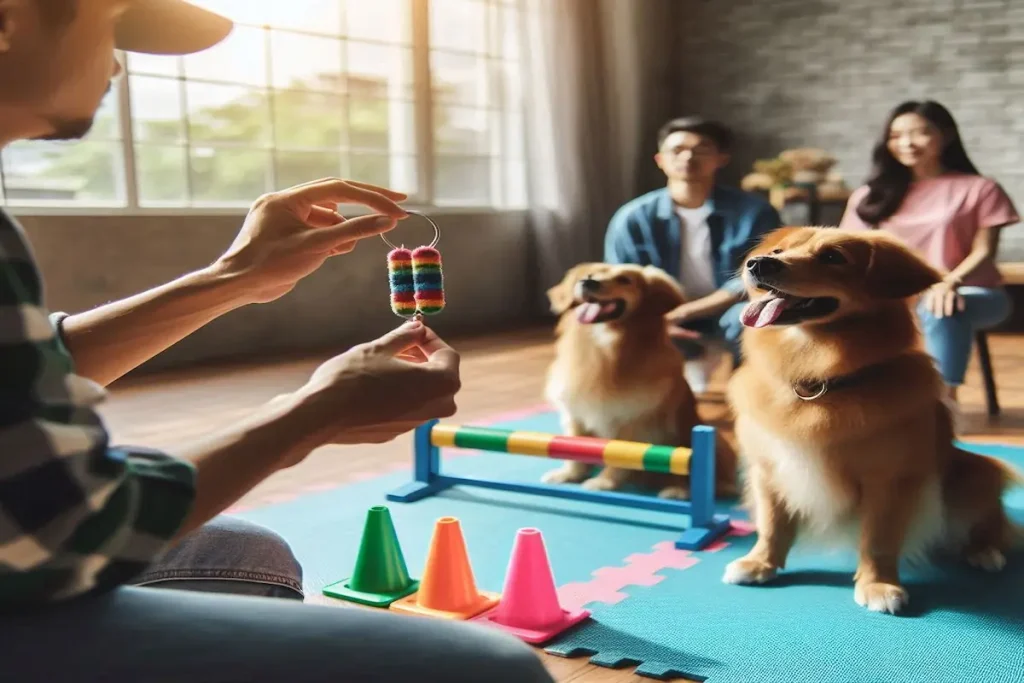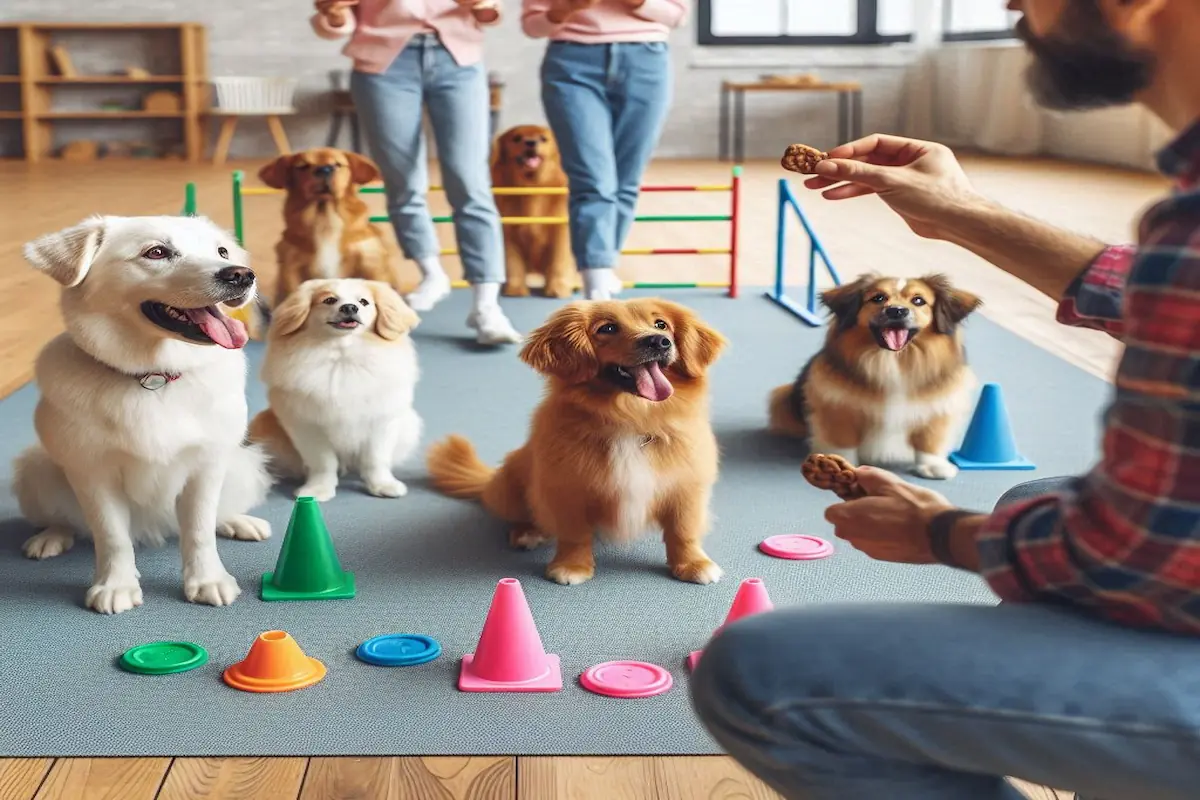Dog Training Words in English
Introduction
Training your dog is not just about discipline; it’s about communication. The words you choose to use during training are the building blocks of that communication. By using clear, concise, and consistent words, you’re helping your dog understand what you want from them. In this guide, we’ll explore essential dog training words in English, why they matter, and how to use them effectively.
2. Why Are Training Words Important?
Imagine trying to have a conversation with someone who doesn’t speak your language. That’s what it’s like for your dog when you’re not consistent with your commands. Training words give your dog a clear signal of what you expect. By using specific words for certain actions, your dog learns to associate those sounds with behaviors. This builds a foundation for a well-behaved and happy dog.
3. Common Dog Training Words for Beginners

If you’re just starting with training, it’s important to focus on basic words that every dog should know. These words form the core of your dog’s vocabulary and can help them navigate daily life. Here are the most essential:
- Sit: One of the first commands most dogs learn. It’s simple, effective, and helps control your dog in various situations.
- Stay: Teaching your dog to stay in one spot is crucial, especially in potentially dangerous situations.
- Come: Recall is one of the most important commands for safety. Your dog should return to you immediately when called.
4. Advanced Dog Training Words
As your dog progresses, you can introduce more complex commands to enhance their obedience and skills:
- Heel: This command teaches your dog to walk closely by your side without pulling on the leash.
- Leave It: Essential for keeping your dog away from harmful or unwanted items.
- Wait: A valuable command for situations where patience is required, like before crossing the street or waiting for their food.
Related: How to Train Your Dog: Essential Tips for Pet Owners
5. How to Choose the Right Words for Training
When selecting training words, simplicity is key. Your dog doesn’t need complicated phrases; one-word commands are easier for them to understand. Choose words that are clear and don’t sound too similar to each other to avoid confusion. For example, “sit” and “stay” work well, but using words like “down” and “no” together might create misunderstandings.
Related: How to Train Your Dog: Essential Tips for Pet Owners
6. How Dogs Understand Words and Tone

Dogs don’t necessarily understand the meaning of words the way humans do, but they are excellent at picking up on tone. If you say “good dog” in an angry voice, your dog might not feel so good about it! The tone in which you deliver commands matters just as much as the words themselves. Use a calm, firm tone for commands and an upbeat tone for praise.
7. Voice Commands vs. Hand Signals
Should you use voice commands or hand signals? Both can be effective, and many trainers use a combination. Hand signals can be especially useful in noisy environments where your dog might not hear you. However, voice commands are more practical for everyday situations. The choice depends on your dog’s learning style and your personal preference.
8. The Role of Positive Reinforcement
Training isn’t just about saying the right words; it’s about associating those words with rewards. Positive reinforcement is a powerful tool. When your dog responds correctly to a command, reward them with a treat, toy, or verbal praise. This reinforces the behavior and strengthens the connection between the word and the action.
9. How to Teach Your Dog New Words
Introducing new words to your dog requires patience and consistency. Start by saying the word clearly, then guide your dog into the desired action. For example, when teaching “sit,” gently push their back end down while saying the word. Immediately reward them with praise or a treat. Repeat this process until your dog begins to associate the word with the action.
10. English Training Words vs. Foreign Languages
Did you know some trainers prefer using commands in foreign languages, like German or French? While English is perfectly fine, some trainers believe that foreign words are less likely to be used in everyday conversation, reducing confusion for the dog. It’s up to you whether you stick with English or branch out into a different language.
11. Why Consistency Matters in Dog Training
Consistency is the secret to successful dog training. If you use different words for the same command or change your tone frequently, your dog will become confused. Stick to one word per action, and ensure everyone in the household is using the same words. This clarity will help your dog learn faster and avoid misunderstandings.
12. Common Mistakes to Avoid When Using Commands
When training your dog, avoid these common mistakes:
- Repeating Commands: Saying the word over and over without action can make your dog think they don’t need to respond right away.
- Using Commands in the Wrong Context: If you tell your dog to “stay” and then call them over right after, it sends mixed signals.
- Yelling: Shouting commands can scare your dog or cause them to shut down. Always use a calm, firm voice.
13. Can You Change a Dog’s Command Words?
Yes, you can change your dog’s command words, but it requires patience. Start by pairing the old command with the new one. For instance, if you used to say “sit” but want to switch to “platz,” say “sit, platz” until your dog associates the new word with the action.
14. Verbal Praise as a Training Tool
Never underestimate the power of verbal praise. Simple words like “good dog” or “well done” go a long way in reinforcing positive behavior. Just make sure your praise is timely, as dogs live in the moment and need immediate feedback to understand what they did right.
15. Understanding the Context of Commands
Dogs are situational learners, meaning they associate words with specific contexts. When you say “down” at home, your dog might understand it. But if you say it at the park amidst distractions, they might struggle. Practice commands in different environments to ensure your dog understands them in various contexts.
16. Pairing Words with Gestures
To maximize communication with your dog, try pairing verbal commands with hand signals. For example, use an open palm for “stay” or point to the ground for “down.” This not only reinforces the word but also gives your dog a visual cue to rely on.
17. How to Keep Your Dog Engaged with Training
Dogs can get bored with repetitive training. Keep things exciting by introducing new commands, mixing up the routine, and adding playtime between training sessions. Short, frequent training sessions are better than long, monotonous ones.
18. The Future of Dog Training: Technology and Commands
With the rise of apps and smart devices, technology is entering the world of dog training. You can now use apps to track your dog’s progress, set reminders for training sessions, and even access virtual trainers. The combination of traditional training methods and technology is revolutionizing the way we communicate with our dogs.
Conclusion
Training words are the foundation of communication between you and your dog. By using clear, consistent, and concise commands, you’re setting your dog up for success. Remember to pair words with positive reinforcement, stay consistent, and make training enjoyable for both you and your dog.
FAQs
Q1: How many commands can a dog learn?
A: Most dogs can learn around 165 words or more, depending on their training and breed.
Q2: Is it too late to train an older dog?
A: No, it’s never too late to train a dog. While puppies learn faster, adult dogs can still master new commands with patience and consistency.
Q3: How often should I train my dog with new words?
A: Short, daily training sessions of 10-15 minutes are ideal for teaching your dog new words without overwhelming them.
Q4: What should I do if my dog ignores commands?
A: If your dog is ignoring commands, reassess your training method. Ensure you’re using positive reinforcement, and practice in a distraction-free environment.
Q5: Can dogs understand full sentences?
A: While dogs may recognize keywords within sentences, they typically respond best to simple, one-word commands.

